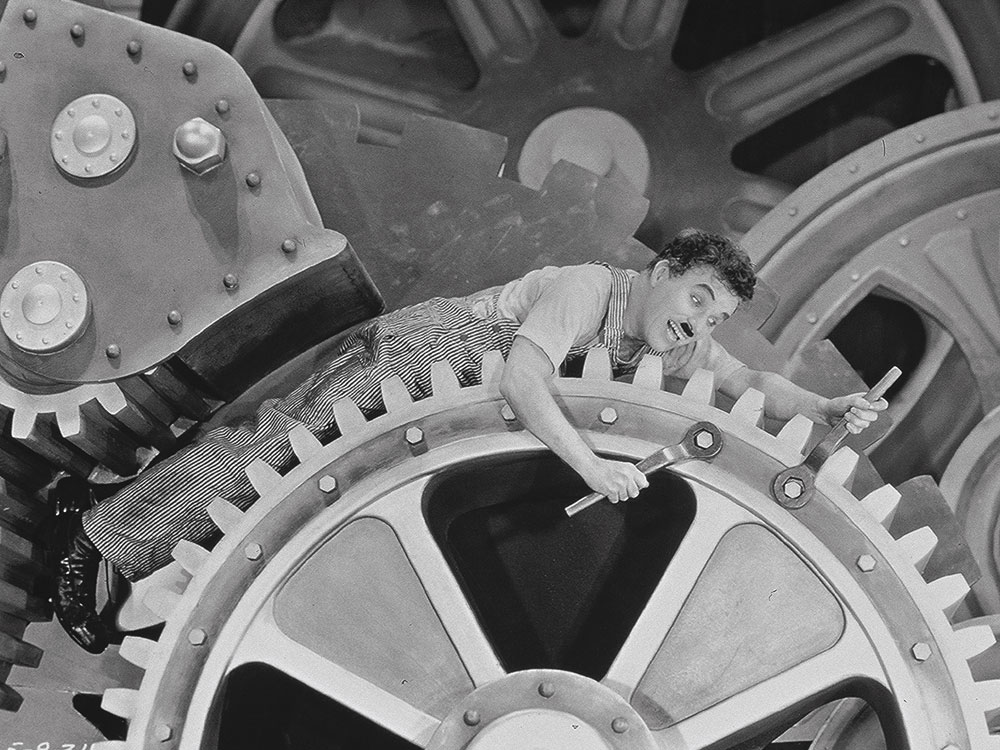In our newly remodeled Modern Art Gallery, a clip of Charlie Chaplin’s 1936 film Modern Times plays next to artworks depicting changes in technology, industry, and society in the twentieth century. In this timely post from 2013, Sara Segerlin, senior manager of public programs and community engagement, reflects on Chaplin’s impact on Modernism.
Speaking remotely via video-chat, controlling robots in space via satellite, and being plugged into the computer and Internet wherever we go are just a few things we take for granted in the information age. Sometimes I just have to laugh at the ridiculous nature of this cyborg technology—supposedly life is becoming easier and humans are now smarter. But if Charlie Chaplin could make a film about us, like he did during his pantomime Little Tramp days, how funny would it be to see a silent film performed by him on the absurdities of the 2000s? I don’t think Conan O’Brien’s skit in the Year 2000 would come close to Chaplin.
Flash back 100 years ago: can you imagine living during the birth of industrialism—with new mechanical technology catapulting human existence into a life surrounded by machines, assembly lines, radio waves, cinema, the automobile, shopping malls, and grocery marts? In the blink of an eye, modernism took hold of our lives, and we humans continued to crank, buzz, pop, and vroom by for better or worse. New obsessions developed with materialism and fashion, travel sped up with planes and automobiles; and moving pictures in silent films became the new way of seeing.
With all of these technological changes in the early twentieth century, we began to see art changing too, morphing from imagery of the traditional old world to new modern perspectives of Cubism, Dadaism, Synchronism, Constructivism, and Futurism. The cubists Pablo Picasso and George Braque painted dramatic geometric forms—breaking down an image frame by frame— almost reminiscent of another newly popular artistic movement: motion pictures.
In all the seriousness of Modernism, there was one person who was able to get the modern world to finally laugh at its new technological self and subliminally question if this new modern reality was a good thing. Thankfully, Charlie Chaplin came to Hollywood just as cinema was beginning to develop. Chaplin’s humble and quirky film performances brought sanity to modern society and humanized the hardships of daily life in this technologically advanced world. Chaplin’s commentary on the life of modern citizens through his film plots and revolutionary performance styles combined his past vaudeville theatre experience and slapstick clown comedy onto the movie screen and would bring people together of many nations, economic statuses, and political parties. Everyone wanted to see Chaplin, and not even Hitler’s censorship nor Russia’s revolution could stop the spreading popularity of Chaplin’s antics on film. Chaplin once said matter-of-factly of his career: “I am known in parts of the world by people who have never heard of Jesus Christ.”
Chaplin was a true artist, creating a total-effect art experience for the viewer. In 1919 he founded United Artists, giving him complete film control, from directing to scriptwriting, acting, and cinematography. His totality in thinking about cinema, comedy, and performance was way before its time. Chaplin’s conveying of a dualistic character—the innocent fool and the humble workman—presented a stylized view of the attitudes of the time. In 1918 he wrote about his character: “Even funnier than the man who has been made ridiculous is the man who, having had something funny happen to him, refuses to admit that anything out of the way has happened, and attempts to maintain his dignity.” He continued: “I am so sure of this point that I not only try to get myself into embarrassing situations, but I also incriminate the other characters in the picture. When I do this, I always aim for economy of means. By that, I mean that when one incident can get two big, separate laughs, it is much better than two individual incidents.
From his heyday of the Tramp film series, Chaplin moved on to create the film Modern Times, a satire on mass production, which at the time gave the actor a reputation as a radical. Chaplin commented on the film: “It [the picture] started from an abstract idea, an impulse to say something about the way life is being standardized and channelized, men turned into machines—and the way I felt about it.” Chaplin’s radicalism towards society, his never-before-seen style of performance—such as his mechanical body mannerisms, facial expressions, and his illusion techniques with the moving image—captivated the social realist and avant-garde artists of the early twentieth century, turning Chaplin into an icon of modernity.
You can watch Modern Times here: http://www.youtube.com/watch?v=YDrmKbOgAbk
A clip from Modern Times is currently playing on this wall (below) in our newly remodeled Modern Art Gallery. See Chaplin’s film next to artists’ interpretations of social changes during this time period.

A clip from Modern Times can be found on the video screen on this wall. Photo by Ironside Photography / Stephen Ironside.







